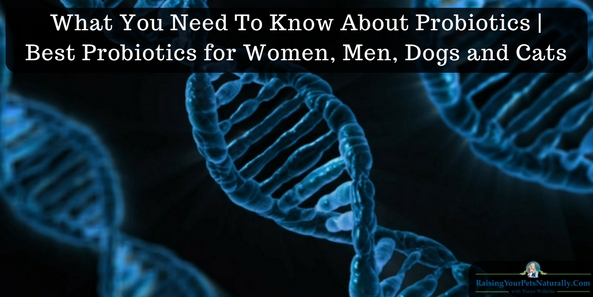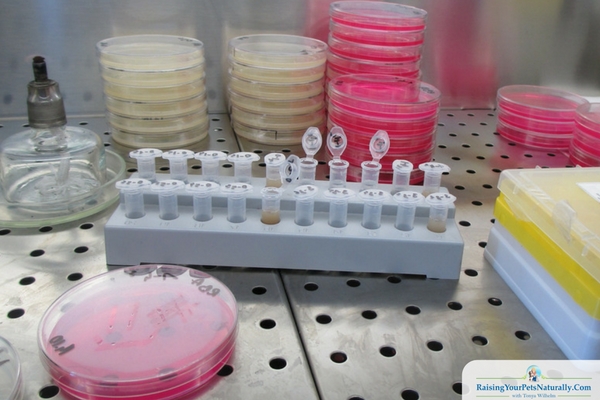Google Adsense—>

Best Probiotics for Women, Men, Dogs and Cats
Understanding Pre- and Probiotics for Dogs, Cats, and People

What do you know about probiotics and prebiotics for ourselves and our pets? I’ve learned over the years that probiotics and probiotics are great for our gut health and our pet’s gut, and have many health benefits. I also know that when a dog, cat, or person is on antibiotics, probiotics should be added. I’ve also learned that prebiotics feed the probiotics, so they work well together. But what I don’t know is how probiotics really work from a cellular level and how to choose (besides what my holistic veterinarian suggests) the best probiotics for my dog, cat, or myself. You know I’m a big believer in reading the ingredient labels in all our pets’ products, but when I turn over a box or jar of probiotics, I’m totally confused. I’m not a microbiologist! So I asked some experts in the field of microbiology and pet health for help in understanding probiotics for pets and ourselves.
Health Benefits of Probiotics for Dogs, Cats and People.
Unless your doctor or veterinarian advises against the use of probiotics, all of us can benefit from the use of daily probiotics. Our health is ruled by our gut. Probiotics aid in good gut health by helping our digestion. They provide good bacteria while inhibiting the bad bacteria. A good probiotic helps soothe the intestines and lessen inflammation, which can assist with diarrhea and irritable bowel syndrome (IBS). Stressed pets and people also can benefit from a healthy dose of probiotics, since stress disrupts our gut.
If you find yourself or your pet on antibiotics or steroids, taking a probiotic or even increasing your probiotic dose may be recommended by your doctor or holistic veterinarian. The use of antibiotics or steroids can decrease the good bacteria in the gut and decrease the immune system. By using a natural probiotic, you can increase your gut health, increase the good bacteria and fight off the bad bacteria.
Choosing the Best Probiotics
Trying to figure out the best probiotic for Dexter The Dog and Nutter The Cat has had me confused for quite some time. I’ve previously purchased pet probiotics from the recommendation of a few great holistic veterinarians, but I really want to be able to wrap my head around how to choose myself. How many CFUs should be in a probiotic? What are the best ingredients in a probiotic? How should a probiotic be stored? These were my top three questions when starting this article.
Holistic Housecall Veterinarian Dr. Patrick Mahaney suggests using a variety of bacterial types to benefit both the small and large intestines. Dr. Mahaney says, “Lactobacillus sp. primarily resides and functions in the small intestine while Bifidobacterium sp. populates the large intestine (colon). Other bacterial varieties can exist in a commensal manner in the small or large intestine besides the above-mentioned.”
Douglas Toal, PhD is a board-certified clinical microbiologist and founder and Chief Scientific Officer of Liberty Bion, and he agrees with variety. He provides this helpful scenario. “A high-quality probiotic supplement includes formulations with a diverse set of beneficial strains and high bacterial count. Look for supplements that have at least 10 strains of healthy probiotics. The supplement should include Lactobacillus and Bifidobacterium species. The most common and clinically proven Lactobacillus species is Lactobacillus acidophilus and this organism can be found in almost all supplements and yogurts. Bifidobacterium lactis is also a popular probiotic that has been extensively studied. Other common probiotics include Bifidobacterium longum, Lactobacillus plantarum, Lactobacillus rhamnosus, Lactobacillus salivarius, and Lactobacillus casei. I suggest finding probiotic formulations with these species since they have evaluated for efficacy.” Mr. Toal continues by saying, “If you introduce probiotics with variety, your chances of finding one that works for you will improve.” He also suggests changing your probiotic variety or brand every three to four months to add diversity.
How many Colony Forming Units (CFU) of probiotics should dogs, cats or humans take? I fell a little short in my search for the answer for our pets. I looked around and various natural pet websites I trust, and found over 5 billion CFU would be a good starting point. For people, Dr. Toal says at least 10 billion CFU per capsule.
Understanding Ingredients in Natural Probiotics
Lactobacillus, Bifidobacterium and Lactobacillus casei….what the heck? You know by now that I want to know exactly what things are and mean when I read a product label. Are those words real food items? Are they synthetic? Healthy? It was time to ask the friendly microbiologist, Douglas Toal. “The strains that are commercialized and sold as probiotic supplements are natural. Keep in mind that these are not food sources nor are they synthesized. Since probiotic strains are living cells – they are able to multiply in the laboratory (i.e., given the right amount of food). Therefore it is possible to grow, multiply and package the strains in manufacturing facilities.” Whew. No way would I have been able to figure that out by reading the label. Dr. Toal continues by telling me, “An interesting aspect of probiotics that most people are not aware of is that each strain was initially isolated from a healthy person (i.e., in the case of Lactobacillus strains, Bifidobacterium strains, and some others) or from an environmental source such as soil (i.e., in the case of Bacillus strains). So the commercial probiotics that we take today were once part of the gut microbiota of a healthy person 10-30 years ago, isolated from the person because of its unique characteristics and then propagated, further evaluated and commercialized.” That’s pretty cool stuff!

Are Prebiotics Necessary When Taking Probiotics?
A 4th generation Japanese herbalist and macrobiologist, Marc Ching offers these tips about the use of prebioticis. “Prebiotics nourish and support the growth of probiotics that in turn support the digestive health and immune system.” Prebiotics can be eaten as whole foods such as apples, asparagus, bananas, flaxseeds, and seaweed. Dr. Toal recommends people eat 4-8 grams of prebiotic fiber each day. He says, “If you are eating enough fruits and vegetables, then you likely do not need prebiotic supplements – although many supplements contain a wide variety of fiber from different sources (i.e., 10 or more different fruits and vegetables). If you are like me – I only eat 3-4 different fruits/vegetables per day and so there is value in finding a prebiotic with a wide variety of fiber from different fruits and vegetables.” He also offers this additional tip, “Since prebiotic fiber can cause bloating, it is important to start with half doses for about a week until the body adapts.”
Understanding Ingredients in Natural Prebiotics
Now I’m back to that ingredient panel. Now that I’ve learned probiotic strains are living cells with weird-looking names grown in a laboratory, what about prebiotics? How do I recognize them on a label? Dr. Toal explained this to me as well. “Since prebiotics should be extracted from fruit and vegetable sources, the ingredients should include the name of the fruit/vegetable that the fiber was extracted from. For instance when the label reads “chicory root inulin” rather than “inulin” then at least you know that it is from chicory root. Also, I recommend looking for the word “organic” in the ingredients such as “Organic Acacia Fiber.” Also, some prebiotic ingredients may indicate that the ingredient comes from a modified source, such as “modified citrus pectin” or “modified potato resistant starch.” In this case the prebiotic was prepared from a modified source – for instance, perhaps the source/product was treated with acid to lower viscosity. So if the consumer is concerned with modified ingredients, then they should avoid prebiotic supplements that contain ingredients that state “modified.””
Read Your Ingredient Label Carefully
Even though seeing the list of probiotic strands may be a bit overwhelming, it’s still super important to read the ingredient panel. Just because a dog probiotic may have good stuff inside, doesn’t mean it doesn’t have things to avoid inside as well. I was reading one pet probiotic label and found some ingredients that were not only unnecessary such as “beef flavor” but downright scary, such as Polysorbate 80, animal digest and other harmful ingredients. So, be careful and read carefully. As a quick side-note, pets do not digest dairy products very well, so I don’t personally recommend yogurt or other milk products to provide probiotics for my pets.
Storing Probiotics
Remember, probiotics are living cells and must be stored properly to survive and to be beneficial to our health. Mr. Ching gave me these tips, “If you find pet food that says they contain probiotics and it is located on an unrefrigerated shelf, walk away. The probiotic is most likely dead by now. Probiotics are to be kept cool; they are very sensitive to heat and moisture. If not kept at cool temperatures, the living organisms inside will die and they will be useless.”
Final Thoughts on Finding The Best Probiotics
After speaking with microbiologist, macrobiologist, and veterinarian, I feel I finally have a handle on how to find the best probiotic for my dog, cat and myself. I wanted to thank Dr. Douglas Toal, Dr. Patrick Mahaney, and Marc Ching for providing such helpful information and answering my questions on probiotics.
Are you or your pets currently taking probiotics? Tell me in the comments.

Are you looking for even more ways to stay up to date with Raising Your Pets Naturally? Sign up for the newsletter for more tips and promotions. Don’t forget to be social and Like, Follow and Subscribe. Comments below are always welcome.
Facebook Twitter Pinterest Instagram YouTube
 |
 |
Google ads





We were first introduced to probiotics several years ago when we were fostering a severely emaciated coonhound. Given her state, it was very important that we were careful about what and how much we fed her, as well as making sure she was digesting properly. May need to add probiotics back to my dogs’ diets. Very informative read!
Thanks, Debbie. My goal is to help consumers know how to choose a probiotic and what to avoid.
There is so much to know and understand about probiotics! To be honest it’s not something I’ve used for my pets, or myself for that matter, but this is such an informative post. Thank you!
Thanks. I can say from experience with myself, my mom and pets, probiotics certainly help the gut and digestion!
Pre and Probiotics can be confusing and a bit overwhelming especially when it comes to my dogs. Thank you for breaking it down so simply. What a great read, will be bookmarking and sharing!
Thanks. I was totally confused at first too. I had to ask the experts to really wrap my head around it.
Thanks for this! I have been wanting to start my cats on probiotics but didn’t know what was best. You gave me some things to think about and to look for in a good probiotic. ~Island Cat Mom
Thanks! I’m so happy this article his helping people understand how to find the right probiotic for their family and pets. It can be so confusing.
This is such great information, you’ve done quite a bit of research! I’m glad to know these products are natural & not man made. I gave Icy probiotics when she was on antibiotics. It’s helpful to know that they should be stored in cooler temperatures. Thanks for sharing!
Love & biscuits,
Dogs Luv Us and We Luv Them
Thanks, Cathy. I tried to find out all the ins and outs to help us make the best choice.
Great information! Probiotics (and prebiotics) are sort of hot-button musts for pet lovers, so it’s helpful to have guidance on such things.
Thanks! Yes, so “in” which is good because they are a great addition. However, it also means some not so healthy companies get on the bandwagon. :+)
Great article, I do not take or give Layla, but I do eat the Greek Yoghurts or Lebanese cheeses with them and love them. Layla does too and as my vet said a little bit will not harm her.
Lebanese cheeses. OK, you peeked my interest.
Thank you for a really helpful post and a good read too. I hd no idea about the bad stuff that potentially might be in probiotics!
I know, right? We try so hard to do right by our pets and ourselves, yet sneaky bad stuff makes it way in some brands.
still not sure how I feel about probiotics… so much info out there sign it’s BS…. and info saying the opposite. UGH. thanks for this…
Interesting. I have yet heard anyone say it was BS
Very interesting about foods that say they contain probiotics but are kept on the shelf. I never thought about that, but of course, they are dead and not healthful. Very helpful article and I will definitely bookmark it for future reference.
Thanks! Since we have been learning that they are so beneficial, companies have been trying to “add” them to their products to say they are there. Education is power.
This is a really informative post — it makes a complicated topic easy to understand. Thank you!
Thanks. I appreciate that.
The doctor has me on probiotics every day to help offset the problems with my Celiac Disease.
Sorry about your Celiac Disease, but glad you’re on a good gut health program.
Great article! Thanks for researching this complicated subject, and explaining it all so well. Did you happen to hear anything about using Kombucha &/or Kombucha SCOBY for a living probiotic source for pets? I homebrew, and have seen some information about using these as supplements for cats & dogs, but haven’t tried it yet.
Thanks! I believe there are folks that do. I have not looked into it yet. Real foods are always a great way to get nutrition. Maybe check http://www.dogsnaturallymagazine.com
Maybe check http://www.dogsnaturallymagazine.com 